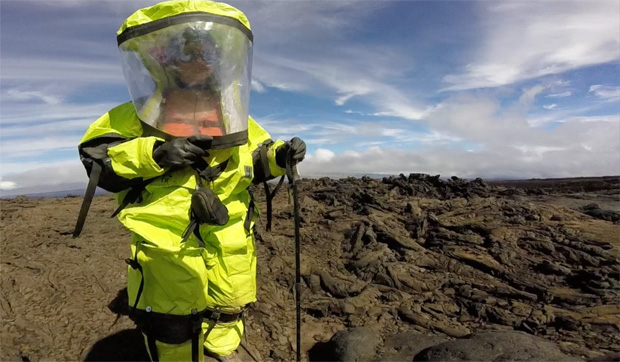The six crew members of the fourth Hawaiʻi Space Exploration Analog and Simulation, or HI-SEAS, have spent more than six months of their 12-month mission in a solar-powered dome on the slopes of Mauna Loa. The crew has been living in isolation as part of a University of Hawaiʻi at Mānoa research project simulating long-duration space travel.
“It’s fun to know you’ve made it halfway,” said crewmember Tristan Bassingthwaighte. The doctor of architecture candidate at UH Mānoa said, “Getting halfway is a great validation in the work you’re doing for yourself, academically or just personally. You also find you’re listening to Life on Mars by David Bowie a lot more often.”
This fourth mission is the longest in HI-SEAS history. As with the previous two missions in the NASA funded study, the current mission is focused on crewmember cohesion and performance.
Crew Commander Carmel Johnston, a soil scientist from Montana, said that she is looking forward to seeing her family. “It will be really fun to go swimming in the ocean, go for a run, feel the wind, smell the rain and other smells of nature, and be able to walk in a straight line that is longer than 20 feet,” she said. “Those things aside, life in the dome is pretty awesome.”
The crew is scheduled to emerge from the habitat August 2016.
In May, NASA awarded HI-SEAS a third grant to keep the research project and its missions funded through 2019.

More HI-SEAS news
- VIDEO: “Year-long HI-SEAS space simulation mission underway” – August 31, 2015
- “Six scientists to spend 365 days in isolation for HI-SEAS simulated Mars trip” – July 29, 2015
- VIDEO: “Third HI-SEAS mission accomplished” – June 19, 2015
- “Clear skies ahead as HI-SEAS wraps up eight-month space simulation” – June 16, 2015
- VIDEO: “Two UH Hilo alumni part of Mars simulation project” – June 12, 2015
- “Longest U.S. space simulation study coming to an end” – June 3, 2015
- VIDEO: “Record-setting space travel simulation underway” – October 16, 2014
- “Crew selected for eight-month Mars simulation” – September 24, 2014
- VIDEO: “Mock Mars mission tests crew cohesion” – July 29, 2014
- VIDEO: “Crew cohesion focus of second Mars simulation mission” – March 31, 2014
- “Team performance factors the focus of new Mars simulation” – February 27, 2014
- “Crewmember participants sought for space studies” – October 7, 2013
- VIDEO: “Groundbreaking space exploration research at UH” – August 14, 2013
- “Long-duration space exploration study awarded NASA grant” – June 14, 2013
- “Contest seeks recipes for Mars mission” – January 28, 2013
- “Crew selected for Mars food mission” – July 6, 2012
—By Kelli Trifonovitch

